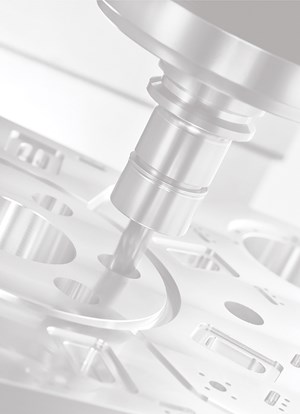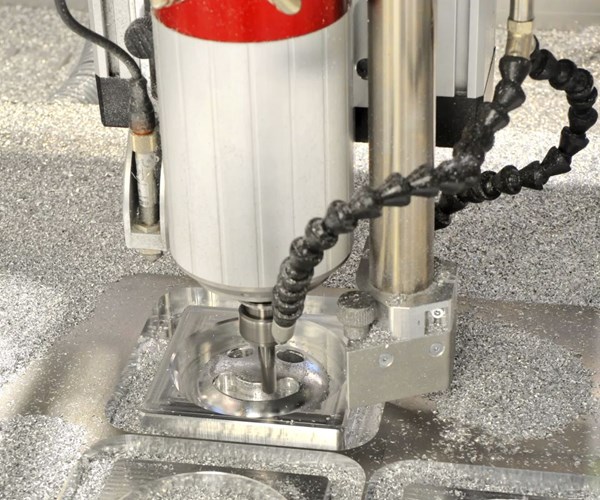Buying a VMC: Considering Toolchanger, Coolant Delivery and Chip Removal
Among characteristics like structure and spindle quality, here are a few factors to consider when buying a vertical machining center.
Share




Chip removal is an important consideration that is often overlooked in the evaluation of a new CNC machine.
Whether it’s for a toolroom, a job shop or a production house, there are a lot of factors to consider when it comes to acquiring a vertical machining center (VMC). Key preliminary considerations include the intended application and workpiece(s) and the needs of a shop’s various departments. And then there’s the research and data-gathering process.
In addition to characteristics like structure and stability and spindle details, potential VMC buyers should keep in mind how the toolchanger, coolant delivery and chip disposal systems contribute to overall machine efficacy.
Selecting the Toolchanger
The toolchanger specified for a new VMC must have an adequate number of tooling pockets and be able to accommodate the size and weight of the cutting tool assemblies. Every VMC has a maximum tool weight and diameter that its toolchanger can handle to prevent a tool from dropping out of the pocket.
In high-production environments, where many tools may be required to machine the parts, tool-change time can have a substantial influence on efficiency. For example, having a machine capable of a 1.4-second chip-to-chip tool-change time, rather than 3.6 seconds, can quickly add up to more productivity and profit.
Coolant Concerns
For certain applications, optional provisions for delivering coolant at high pressure directly through the spindle are recommended. Coolant pressure as high as 1,000 psi is intended to promote chip evacuation from deep bores in which chip breaking is directed at the tool point. Unlike time-consuming peck-drilling cycles, through-the-tool, high-pressure coolant enables the material to be removed in one pass. This approach may reduce drilling time by as much as 30 percent. Additionally, the part remains cooler, surface finishes inside the bores are protected, accuracy of the parts is maintained and cutting tools last longer.
For high-pressure coolant, the capacity of the coolant tank may need to be enlarged. Likewise, an oil skimmer may be an option to consider for extracting waste oil from water-soluble coolant.
Chip Removal
Chip removal is an important consideration that is often overlooked in the evaluation of a new CNC machine. Whether chips are evacuated from the machining zone with water, oil or air jets, they will fall to the bottom of the machine. A smaller volume of chips can be removed by an auger, which is typically standard on most VMCs, but a large volume of chips may require a conveyor. Although it is possible to have the machine operator manually remove chips from the machine, this task is labor-intensive and messy. Using a chip auger or conveyor to remove chips automatically and deposit them in an external bin is recommended. Pay attention to whether the chip conveyor or auger evacuates the chips from the side or rear of the machine, however. The location of the chute determines how much space will be needed on the shop floor, how close the machine can be placed to other machines or walls, and how easily a fork truck can retrieve a loaded chip bin.
Do Your Research
Techspex.com, a free research center and analysis tool, can help a shop find the right VMC for the job. Simply enter the basic attributes and specifications that are required, and the system will provide a side-by-side comparison by machine type, model and builder.
This is part three of a three-part series about buying a VMC.
- Part one: Considering Structure and Stability
- Part two: The Basics of Spindle Speeds and Tapers
Find more insights about acquiring a new machining center by visiting the Techspex Knowledge Center, “Guide to Buying Machine Tools.”
This blog post was adapted from an article by Barry Rogers published in the Machine/Shop supplement to Modern Machine Shop magazine.
Related Content
4 Manufacturing Trends That Cannot Be Ignored
The next five years will present their own unique set of challenges, and shops can alleviate them by embracing these technologies and trends.
Read MoreHave you Shown Your Value to Customers?
Showing your shop’s value is about more than simply offering the best price.
Read MoreUnderstanding Process Damping in Milling Operations
Despite the advances in modeling machining operations over the past decades, process damping remains a topic of interest, including new tool designs that increase the effect.
Read MoreHow to Determine the Currently Active Work Offset Number
Determining the currently active work offset number is practical when the program zero point is changing between workpieces in a production run.
Read MoreRead Next
OEM Tour Video: Lean Manufacturing for Measurement and Metrology
How can a facility that requires manual work for some long-standing parts be made more efficient? Join us as we look inside The L. S. Starrett Company’s headquarters in Athol, Massachusetts, and see how this long-established OEM is updating its processes.
Read More























